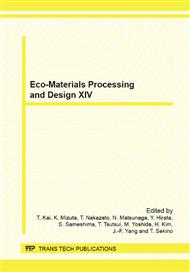p.11
p.15
p.19
p.23
p.27
p.35
p.41
p.49
p.55
Fabrication and Thermoelectric Properties of Al-Doped (ZnO)5In2O3 by Microwave Heating
Abstract:
Various (ZnO)5In2O3 ceramics were fabricated by microwave heating. Density, XRD pattern and microstructure were examined and those of Al-doped (ZnO)5In2O3 were almost the same as Al-free one. Highly textured (ZnO)5In2O3 ceramic was also fabricated by reactive templated grain growth (RTGG) method. The electrical conductivity was not improved by Al-doping; however it was improved slightly by microwave heating compared with conventional heating and especially improved by texturing using RTGG method. On the other hand, the absolute Seebeck coefficient in microwave heating was improved about 25% by Al-doped. Maximum electric power factor of textured specimen fabricated by RTGG method along ab-plane showed 5.76×10-4 WK-2m-1 (at 873K), which was attributed to high electrical conductivity.
Info:
Periodical:
Pages:
27-31
Citation:
Online since:
July 2013
Authors:
Price:
Сopyright:
© 2013 Trans Tech Publications Ltd. All Rights Reserved
Share:
Citation:


